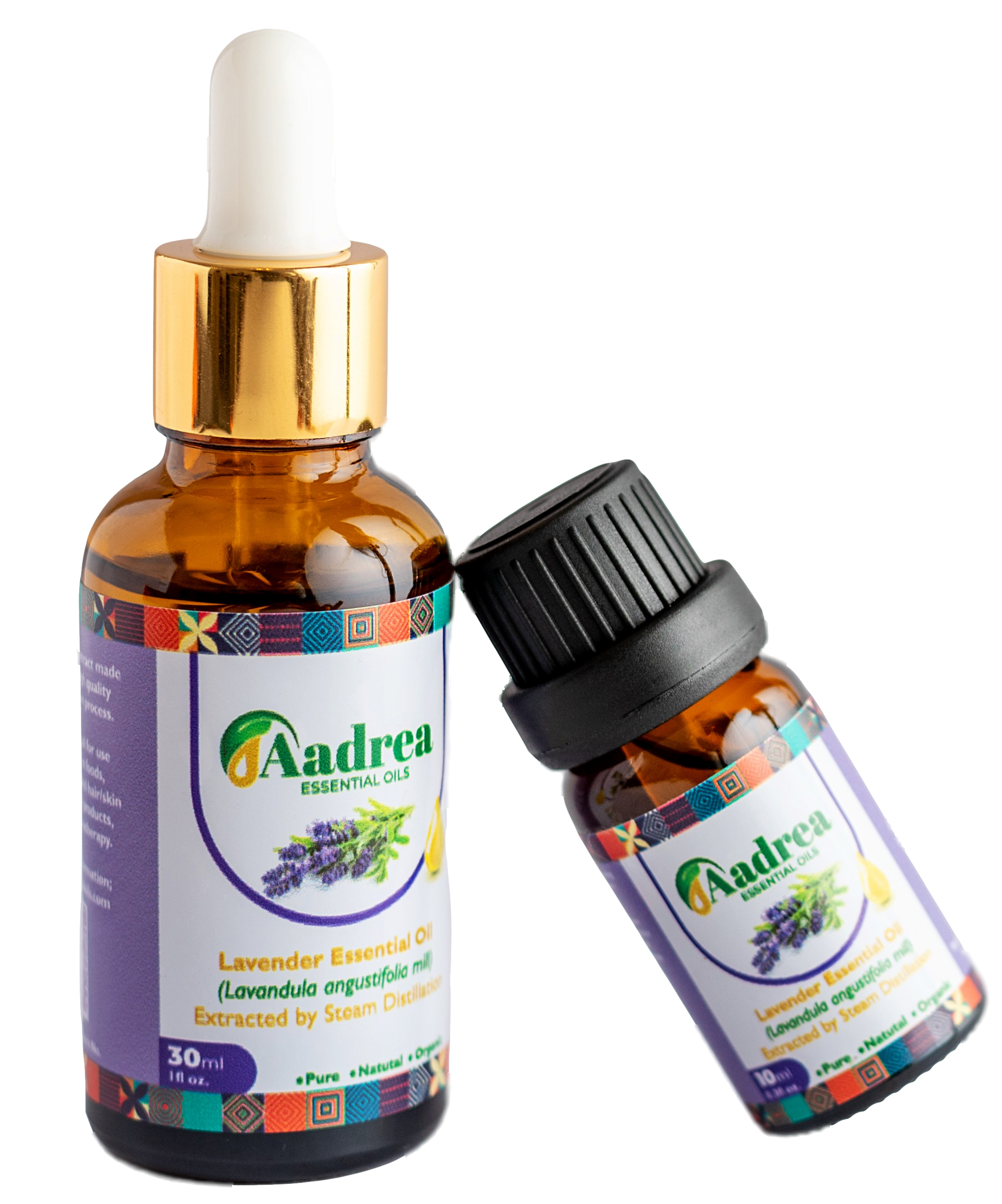Lavender essential oil
Aadrea Lavender essential oil is extracted from the stock of Lavandula angustifolia mill, from fresh flowers and branchlets, through the process of steam distillation. The main supply of the stock is clonal lavender, which is propagated by cuttings, which are sourced from locally grown farms by farmer households and groups.
Identification:
Lavender essential oil is an extract which presents as a pale-yellow mobile liquid, with a characteristic fresh floral odour. The active component(s) in a typical oil sample are Linalool (20–52%), Linalyl acetate (10–25%), Camphor (6–9%) and others.
 Indications (benefits from use of product):
Indications (benefits from use of product):
Lavender essential oil is a herbal extract/product . Volatile oil from Lavandula angustifolia has been considered a natural remedy for various diseases for centuries. It has antibacterial, antifungal, antioxidant, and immuno-stimulating action. The linalyl acetate fraction of lavender essential oil is attributed sedative and calming properties, while the linalool fraction confers antibacterial, antispasmodic, anxiolytic, anti-insomnia, and antioxidant properties of lavender. Further, due to lavender essential oil’s antioxidant properties, it’s potentially effective for improved brain function, reducing brain oxidative stress and improving cognitive impairment. It can be useful to reduce skin conditions, from canker sores to allergic reactions, acne, and age spots.
How to Use:
Massage and Spa therapy: Lavender essential oil is used in aromatherapy, to promote relaxation and is believed to treat anxiety, fungal infections, allergies, depression, insomnia, eczema, nausea, and menstrual cramps. A carrier oil of choice should be selected before the dilution is done. Combined with other essential oils such as rosemary, lavender has been credited for supporting hair growth and mitigating the effects of alopecia (hair fall) when massaged in the scalp daily. Carrier oils are vegetable oils which reduce help the oil get into the skin, reducing the concentration without reducing potency. For every 15-30 drops of essential oil, use at least 10ml of carrier oil (Olive Oil, Coconut Oil, Jojoba Oil are excellent local options of carrier oils). Blend with carrier oil of choice prior to massage to minimize any skin sensitivity.
Inhalation: Breathing in the scent of lavender essential oil or applying lavender essential oil to the skin transmits messages to the limbic system, a brain region known to influence the nervous system and help regulate emotion. Add six to eight drops to hot water in a bucket and use as a facial steam. Alternatively, add two to three drops in handkerchief, place over nose and inhale.
Skin rubs: For tension headaches which are often caused by muscle contractions, and many allergic reactions, a blend of lavender and peppermint essential oils may provide some relief. Dab a couple drops of your oil mixture onto your fingers and massage it onto your temples, the back of your neck, your shoulders, and your chest area.
Using a Diffuser/Humidifier: Use three to four drops in diffuser of choice with 100ml of clean water to generate the vapour. You can diffuse Lavender essential oil in the bedroom or living areas to relieve allergies and enhance sleep quality.
Flavorant for foods and beverages: Lavender essential oil can enhance flavours of cakes, puddings, muffins, teas and even salad dressings. It’s completely edible, but only use high-quality, 100% pure grade oil. Add 1–2 drops to your recipes for a surprising flavour booster.
Cosmetic and Perfumery use: An essential ingredient, providing a middle note/floral scent in perfumery, cosmetic products to relieve skin conditions listed above.
Antiseptic: For use on wounds, cuts, burns, bites, stings, and sores, especially more likely to have better efficacy when blended with either of clove, cinnamon, or tea tree oils.
Side effects and management in event of misuse/ingestion:
Lavender essential oil is generally well tolerated, but its use is associated with allergic reactions rarely reported for users with skin sensitivity.
Wilful misuse of Lavender essential oil can take the form of oral ingestion or use of undiluted concentrate in excess proportions. In both instances, decontamination will be necessary, and in the case of oral ingestion and allergic reaction, seek the help of a trained medical practitioner.

Additional information:
Aadrea Lavender essential oil is packaged in durable aluminum cans or labelled amber bottles with a dropper. Alternative packaging and seals will be specified as they become available.
Essential oils are lose their potency when exposed for long periods to oxygen and sunlight. Store the oil in its original sealed container, in a cool dark space.
Before Use:
Lavender essential oil can be highly toxic when ingested. Small ingestions of pure oil (≥1mL) can lead to severe symptoms. The raw oil concentrate might be generally well tolerated in low doses when ingested (<5 drops) but should not be ingested or applied through oral ingestion, except where a competent prescription has been given by a trained practitioner, or as part of a culinary preparation. Pregnant and nursing women are particularly cautioned to avoid using the essential oil without medical guidance.
The essential oil should be applied topically (on external surfaces of the body), and preferably diluted; using the oil directly or in high concentrations can potentially cause skin irritation. A skin test is recommended prior to use. Lavender oil must never be used near the eyes, inner ears, or on any other particularly sensitive areas of skin.
The oil is generally safe for use on adult skin but should never be applied to the face of infants. Individuals who suffer from allergic sensitivities could potentially experience skin irritations with the use of Lavender oil, which could be uncomfortable, and potentially dangerous in higher exposure amounts.
Our essential oils, oleoresins, absolutes and hydrosols have been made using an ideal and chemical neutral /free process of either steam distillation, cold press and supercritical extraction. The purity of the oils has been ensured by keeping the amount of hydration/water content and other elements at the lowest level. With this in mind, we are confident that the product will remain effective if you store it in its primary bottle/container, away from direct sunlight, excessive heat and minimize the periods the bottle is opened (during which the oil potentially gets exposed to oxygen).
Your essential oil should remain viable (with the full optimal potential to deliver the intended benefit) for an average of 36 months (3 years)*** from the date of its manufacture.

